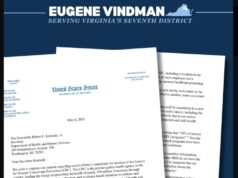cross-posted from Main Street Insider
We’re nearing the end of our first season and to finish it off we are providing a couple summaries relating to changing the filibuster. Today we look at what is called the “Constitutional Option,” which applies only to the first day of a new session of Congress. This is expected to come up at the beginning of the 112th session.
As always, one-pager below the fold…
Update: This morning, a staffer for Senator Udall dropped us a line and asked us to include a point about holding obstructionists and abusers of the rules accountable. A version of that point has been added to the “supporters” section of the one-pager.
Senate Rules Reform and the 112th Congress
Part 1 of 2: The “Constitutional Option”
Key Proponent: Sen. Tom Udall (D-NM)
Click here to download this summary (pdf)
Status: Currently in discussion within the Senate Democratic Caucus. The measure is expected to be brought up by Sen. Udall on the first day of the new session, January 5th, 2011, and will pass if it receives 51 votes (or 50 plus V.P. Biden). The Democratic Caucus will have 53 members at the time, including Independent Sens. Lieberman and Sanders, so assuming no Republicans support the measure, they can only afford to lose three members. It is currently unclear whether proponents will be able to garner majority support for the resolution.
Purpose: The Senate has been traditionally known as the deliberative “cooling saucer” of the American government, where the minority right to filibuster can counteract the worst impulses of a majority. But now, in a time of great national distress, many view the filibuster as an enabler of mindless obstruction rather than a tool to promote debate and compromise. Indeed, the percentage of legislation affected by threatened or actual filibusters has risen from 8% in the 1960s to some 70% in the 110th Congress.
Generally, closing debate on Senate rules changes requires a 2/3 supermajority to pass. However, there may be a justifiable exception on the first legislative day of a new Congress. This possibility opens the door for frustrated Senate Democrats to reform the filibuster rules with a simple majority.
Summary: The Constitutional Option, if affirmed on the first legislative day of a new Congress by a majority of Senators duly chosen and sworn, would close debate on rules changes and proceed immediately to a vote on any rules changes considered in order.
Some key features of the measure:
• Does not contain any substantive changes to the rules in itself;
• Does not apply at any time other than the first legislative day of a new Congress (which may not be limited to a single calendar day);
• Requires the President of the Senate (specifically, Vice President Biden) to rule the motion in order, regardless of how many Senators stand in support.
• The motion can be (though not necessarily must be) specific to rules changes related to filibuster reform, with other changes considered out of order.
The maneuver is almost universally considered to be constitutional. Given that Article I, Section 5 of the Constitution states that “Each House may determine the Rules of its Proceedings”, meaning rules governing Senate operations are the exclusive responsibility of Senators themselves, it is highly unlikely that the Supreme Court would consider a challenge.
As well, there is ample historical precedent for such a procedure, dating back to Henry Clay in the 1840s. More recently, three Vice Presidents have delivered opinions from the chair in support of the move.
Supporters: Many Senate Democrats including caucus leadership, dozens of constitutional scholars, Common Cause, etc.
• Supporters see this measure as necessary to achieve filibuster reform in the 112th Congress and beyond. In turn, they believe filibuster reform to be crucial to meeting the nation’s critical economic, energy/environmental, foreign policy and national security goals. They also argue that the Constitutional Option discourages abuse of the rules by allowing obstruction tactics to be reviewed at the beginning of each Congress.
Opposition: Most/all Senate Republicans, movement conservatives, retiring Sen. Chris Dodd
• Opponents recoil at the calls to upend longstanding practice in a legislative body primarily defined by its adherence to tradition. They see the Senate as a unique body whose proper function depends on consensus, and changes to the rules by simple majority would change the Senate for the worse, increasing acrimony and making it much more like the House.
Further links
Sen. Udall brief with video explanation and background info: http://tomudall.senate.gov/?p=blog&id=719
Constitutional Option FAQs, via Sen. Udall: http://tomudall.senate.gov/files/documents/Blog/Constitutional_Option_FAQs.pdf
Website of supporting coalition: http://fixthesenatenow.org/
Sen. Dodd’s farewell speech: http://dodd.senate.gov/multimedia/2010/SenatorDoddValedictoryAddress.pdf
RedState.org commentary: http://www.redstate.com/brian_d/2010/12/01/filibuster-reform-is-unwise/
David Waldman explanation of the Constitutional Option: http://www.dailykos.com/story/2010/8/7/890169/-Filibuster-reform-background:-the-constitutional-option














![Monday News: Trump’s Lunacy Pushes China, Russia, India, etc. Together; “Happy Labor Day. Donald Trump and Elon Musk Are Screwing Workers.”; “Where is the [media’s] intense focus on Trump’s failing health?”; ““Trump says he is not a dictator. Isn’t he?”](https://bluevirginia.us/wp-content/uploads/2025/09/montage0901-100x75.jpg)